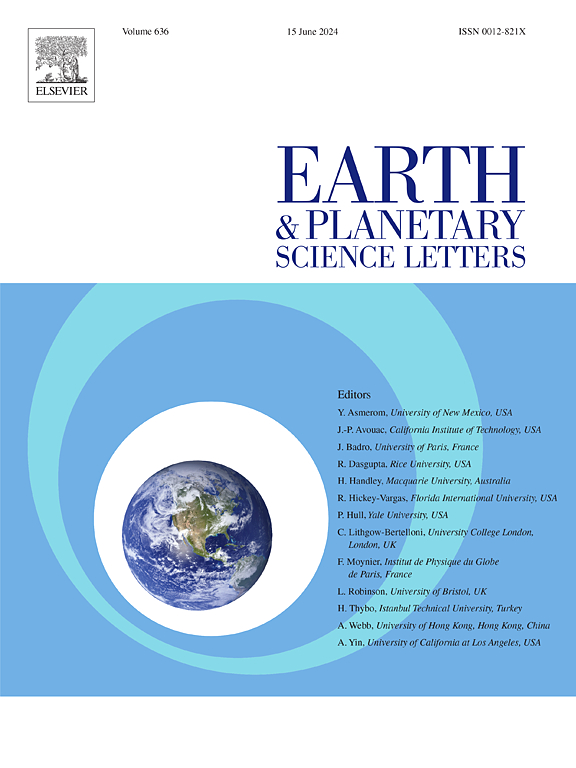融化马里诺雪球地球:脱冰期对大陆边缘海平面历史的影响
IF 4.8
1区 地球科学
Q1 GEOCHEMISTRY & GEOPHYSICS
引用次数: 0
摘要
马里诺雪球地球的终止(635 千兆年前)代表了地球气候的重大转变。帽状碳酸盐地层及其下的冰川沉积物记录了全球冰川消融,并保存了不同的相对海平面历史,代表了全球平均海平面上升与冰川等静力调整和沉积作用等区域作用力的交汇。例如,在纳米比亚中部 Naukluft 山的帽状碳酸盐岩露头,岩相转换显示了水深加深和水深变浅的两个阶段。尽管许多因素可能导致了这种冰川期相对海平面变化的模式,但我们在此考虑了这种模式以及其他非单调海平面历史由冰川等静力调整驱动的可能性。我们模拟了全球同步和连续的马里诺冰川退缩导致的冰川等静力调整引起的相对海平面变化,并探讨了冰川退缩的持续时间如何影响大陆边缘相对海平面变化的范围。雪球降冰期较短,约为∼2 kyr,会导致完全的相对海平面上升,或相对海平面上升后出现相对海平面下降,但无法驱动两个不同阶段的相对海平面下降。然而,持续时间较长(10-30 千年)的雪球冰川可以在大陆边缘的大部分宽度上驱动两个不同的相对海平面上升和下降阶段,这可能是在瑙克鲁夫特山碳酸盐盖层中观察到的地层模式的原因,尽管我们不能排除这种模式是由沉积物供应的变化或其他因素引起的。这项研究强调,需要从实地观测中更好地了解马里诺冰盖的面积分布和体积,并从全球气候模型中了解合理的冰期持续时间。本文章由计算机程序翻译,如有差异,请以英文原文为准。
Melting the Marinoan Snowball Earth: The impact of deglaciation duration on the sea-level history of continental margins
The termination of the Marinoan Snowball Earth (∼635 Ma) represents a significant transition in Earth's climate. Cap carbonate strata, and underlying glaciogenic deposits, record global deglaciation and preserve diverse relative sea-level histories, representing the intersection of global mean sea-level rise with regional forcings such as glacial isostatic adjustment and sedimentation. For example, at cap carbonate outcrops in the Naukluft Mountains of central Namibia, facies transitions reveal two intervals of water-depth deepening and shallowing. While many factors may have contributed to this deglacial pattern of relative sea-level change, here we consider the possibility that this, and other, non-monotonic sea-level histories, were driven by glacial isostatic adjustment. We modeled relative sea-level change due to glacial isostatic adjustment for a globally synchronous and continuous Marinoan deglaciation, and explored how the duration of deglaciation impacts the range of resulting relative sea-level patterns across continental margins. Short Snowball deglaciation durations, on the order of ∼2 kyr, result in exclusive relative sea-level rise, or relative sea-level rise followed by relative sea-level fall but cannot drive two distinct phases of relative sea-level fall. However, longer duration Snowball deglaciations, of ∼10–30 kyr, can drive two distinct intervals of relative sea-level rise and fall across much of the width of a continental margin, which may have contributed to the stratal patterns observed in Naukluft Mountains cap carbonate, though we cannot exclude that the pattern arises from changes in sediment supply or other factors. This work underlines the need for better constraints on the areal distribution and volume of Marinoan ice sheets from field observations, as well as plausible deglacial durations from global climate models.
求助全文
通过发布文献求助,成功后即可免费获取论文全文。
去求助
来源期刊

Earth and Planetary Science Letters
地学-地球化学与地球物理
CiteScore
10.30
自引率
5.70%
发文量
475
审稿时长
2.8 months
期刊介绍:
Earth and Planetary Science Letters (EPSL) is a leading journal for researchers across the entire Earth and planetary sciences community. It publishes concise, exciting, high-impact articles ("Letters") of broad interest. Its focus is on physical and chemical processes, the evolution and general properties of the Earth and planets - from their deep interiors to their atmospheres. EPSL also includes a Frontiers section, featuring invited high-profile synthesis articles by leading experts on timely topics to bring cutting-edge research to the wider community.
 求助内容:
求助内容: 应助结果提醒方式:
应助结果提醒方式:


